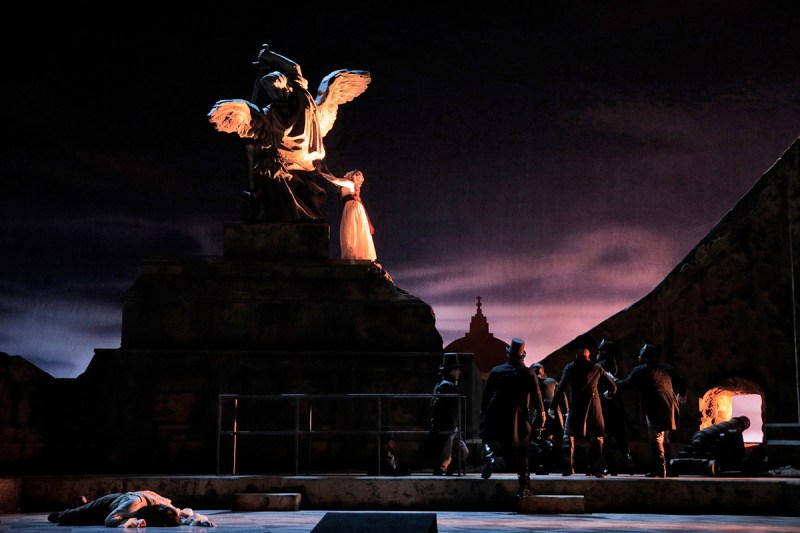Opera critics consider Giacomo Puccini’s “Tosca,” which is now playing at the San Francisco Opera, to be the epitome of the verismo style. When the opera premiered in 1900, many Italian composers were tired of writing of kings and queens, gods and nymphs. Thus, they became interested in everyday life. As scholar William Schoell writes, verismo operas strove to capture “the average contemporary man and woman and their problems.”
The characters in “Tosca,” however, are not contemporary people. The opera is set during the Napoleonic era, a full century before Puccini’s time, and the protagonists’ problems are not average in any sense. The heroine of the piece is the pious singer Floria Tosca. Her paramour is the painter Mario Cavaradossi. She believes that he has fallen in love with another woman, but actually, her suspicions are unfounded. Cavaradossi engages in clandestine activities because he is trying to save the life of an escaped political prisoner. His efforts are not entirely successful. The venomous police chief Scarpia is on the verge of finding the fugitive. Furthermore, he seeks to tear Tosca away from Cavaradossi so she can be his.
While this synopsis of “Tosca” makes the opera seem like a petty potboiler, Puccini’s haunting melodies cut through the sordidness of the story. Puccini transforms “Tosca” from a maudlin melodrama into a musical masterpiece.
In approaching “Tosca,” some directors try to sidestep the salacious elements. They stage the opera so it takes place in another period or an abstract wasteland. By removing the story from its setting, they make the struggles of Tosca, Cavaradossi and Scarpia into complex allegories. In her new production for the San Francisco Opera, however, Shawna Lucey elects to keep the tale in Rome in 1800, and she does not shirk from the opera’s sensational aspects. For example, Puccini’s librettists, Luigi Illica and Giuseppe Giacosa, devised a dramatic finale for Act I. As he participates in a church processional, Scarpia vows that he will possess Tosca. Lucey revels in the resplendence of the moment. A plethora of priests and choir boys stand behind Scarpia when he makes his declaration. The gold and glitter on their costumes are lustrous. By including this scene, Illica and Giacosa meant to suggest that Scarpia is a religious hypocrite, but Lucey’s staging shows that they were not successful in remaining subtle. In this ostentatious milieu, Scarpia is not merely suggesting his hypocrisy, but flagrantly exhibiting it.
The singers also embrace the extravagant elements of the piece. Scott Hendricks sings Scarpia’s part powerfully. He demonstrates that Scarpia has deep-seated desires, and he will not surrender until they are satisfied. As Caravadossi, Brian Jagde emphasizes the pathetic qualities of his character’s plight. His voice compliments Carmen Giannattasio’s, who is a superb Tosca. Giannattasio expresses Tosca’s fragility and frigidity. At the start of the opera, Tosca is powerless before Scarpia, but towards the end of Act II, she stabs him. Giannattasio elucidates every stage of Tosca’s transformation from victim to assassin. As the knife goes into his heart, Tosca asks Scarpia, “Are you choking on your own blood?” Giannattasio sings the line with a captivating combination of earnestness and relish. Lucey’s production allows the singers to savor these exorbitant moments.
Puccini’s magnificent score accompanies the action on stage. How can someone describe the poetic “E lucevan le stelle” or the chilling “Te deum” chorus in words? Perhaps they could be called “sublime.” The 18th-century philosopher Edmund Burke once asserted that sublime works “excite the ideas of pain and terror.” The plot of “Tosca” is certainly full of pain and terror, but as Burke declared, “when danger and pain press too nearly, they are incapable of giving any delight.” Yet, “at certain distances, and with certain modifications, they may be… delightful.”
Puccini’s score makes it possible to delight in the grand excesses of “Tosca.” When Tosca sings, “Are you choking on your own blood,” the music becomes melodic and lush. Here, Puccini modifies the story. He creates a contrast between his harmonies and the horrific events on stage. Therefore, the opera suddenly acquires depth.
The music makes the characters seem multifaceted as well. Just before Tosca kills Scarpia, she sings “Vissi d’arte”— “I Have Lived for Art.” She prays to God and implores Him to reveal the reason why she deserves to be treated so terribly. She protests that she has always been pious and has never harmed a living soul. Taken on its own, the text for the aria makes Tosca sound like an impetuous complainer. Yet, the haunting melody underscores the sincerity of her prayer. In this moment, Tosca does seem like a real person with regrets and anxieties.
“Tosca” has been performed at the San Francisco Opera at myriad times in the past. It was featured in the 1978 season, and San Francisco City Supervisor Harvey Milk attended a performance. The day after, he would meet Scarpia’s fate. Dan White walked into City Hall and murdered Milk. Immediately after the performance, however, Milk was elated. Unaware of what would happen to him tomorrow, he wrote to a friend that after seeing the opera, he understood why “life is worth living.”
Even if “Tosca” does not show us “the average man and woman and their problems,” Puccini’s music is still a testament to life. While Lucey’s production highlights the melodramatic elements of the opera, Puccini’s melodies make this tale of murder, corruption and lust immediate and emotional. Puccini’s skill in “Tosca” makes viewers agree with his heroine—what else is there to live for but art?
Contact Amir Abou-Jaoude at amir2 ‘at’ stanford.edu.
